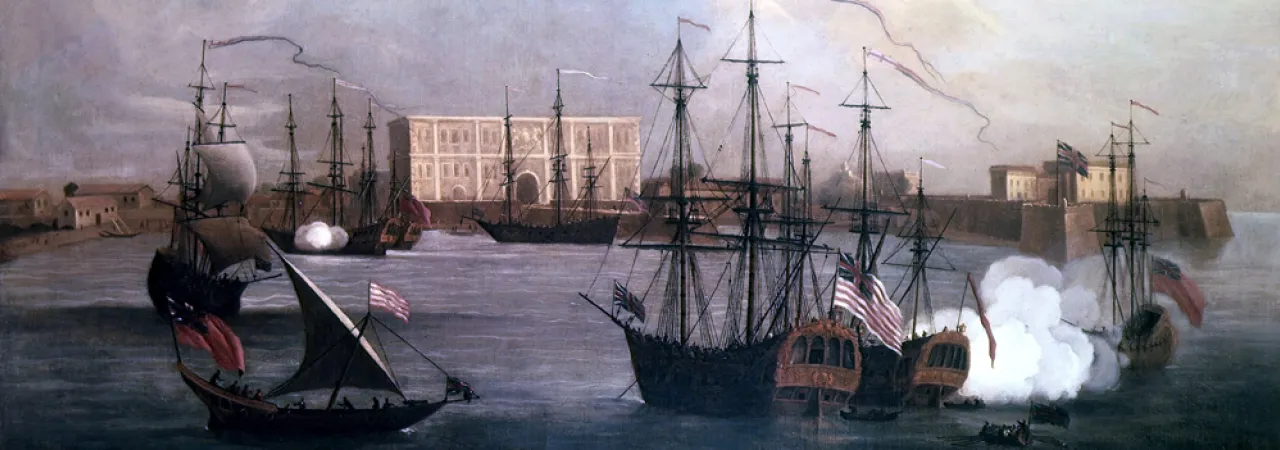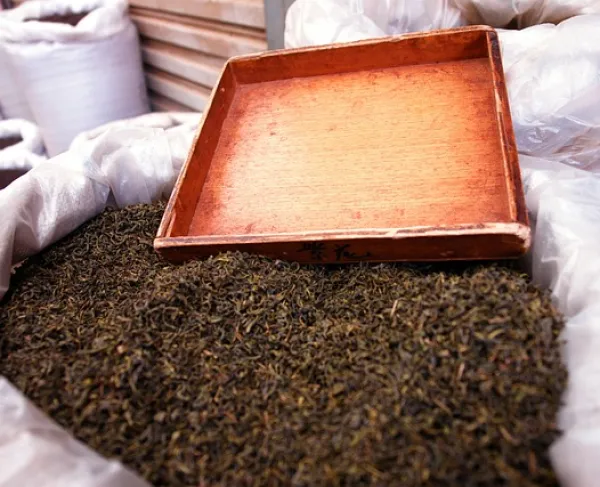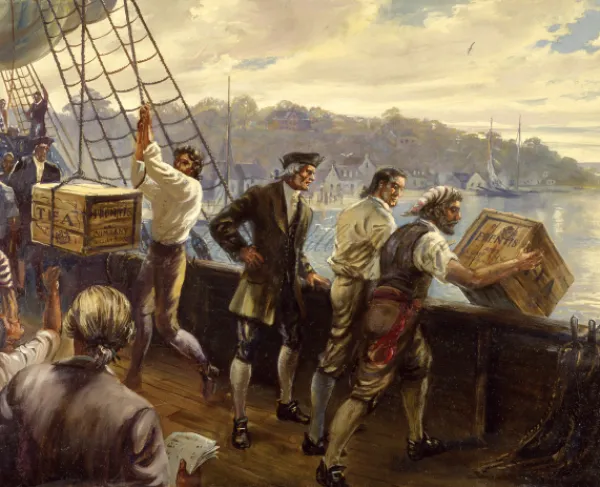
"Ships in Bombay Harbor, 1731"
The history of the British East India Company encompasses nearly three centuries and reflects Britain’s rise to a global power, the expansion of European imperialism, and the tremendous growth in international trade in the 17th, 18th, and 19th centuries. The company had access to an unprecedented source of wealth when it was given a monopoly over British trade in India and China, and it soon transformed from a solely commercial venture to an imperial power in its own right, fighting wars and ruling over vast swaths of territory in South Asia. The sale of tea to the North American colonies was only one part of the company’s commercial network, which brought luxury goods like Chinese porcelain or Indian calico along with tea to Western markets. But the tea trade soon affected the path of history, when the colonists’ reaction against the British Parliament’s tax on tea and the company’s monopoly proved a catalyst for the American Revolution and the foundation of the United States.
For a company which would one day act as a sovereign nation, with tremendous resources of wealth, land, and labor, the East India Company had small beginnings. After the destruction of the Spanish Armada in 1588, Spanish and Portuguese dominance in the East Indies (today South Asia including the Indian coast and Malay Archipelago) declined and an opportunity for English merchants to enter the spice trade appeared. The East India Company--often known as the British or English East India Company to distinguish itself from its competitors--was founded in 1600, during the rule of Queen Elizabeth I. She issued a charter which created a monopoly on English trade to the East Indies and allowed a few merchants to band together and fund voyages to the area. This distributed risk across participants and gave individuals the ability to subscribe separately to each new venture. In 1612, the company instituted a simple, temporary joint-stock system; the joint stocks became permanent in 1657.
Although the East India Company’s first aim was to secure spices, they soon expanded their business to trade in cotton, silk, indigo, tea, and saltpeter (an ingredient used in gunpowder.) Competition was intense, especially with the Dutch. Company ships fought their international competitors in sea battles like the Battle of Swally in 1612. These conflicts escalated to the level of war between England and the Netherlands three times in the 17th century. The company originally enjoyed the favor of the Mughal emperors and established fortified trading posts, known as factories, in Java and India.
In the 18th century, the company participated in the slave trade, especially in the middle decades of the century. It was most heavily involved not in American slavery but in transporting enslaved Africans from East Africa to India and Indonesia. The slave trade declined at the end of the century and was outlawed in the British Empire in 1807, although there is evidence that the company illegally continued the trade for years. Slavery would be abolished completely in the British Empire in 1833.
The East India Company’s monopoly on English trade with India soon expanded to China, importing porcelain and tea to Great Britain and its colonies and flooding Chinese markets with opium. The eighteenth century also saw the consolidation of the company’s rule in India and its victory in the Anglo-Mysore and Anglo-Maratha wars. Without considerable government oversight until the 1770s, the company essentially existed as its own imperial power, running British colonies in the interests of shareholders and possessing its own military force. It also had significant lobbying power in Parliament. In the eighteenth century, Britain’s rivalry with France began to take precedence over conflict with the Dutch. Part of the Seven Years’ War, known in North America as the French and Indian War, was fought with company troops against the French in India.
The British East India Company’s monopoly on tea proved lucrative as the commodity grew in popularity across the British Empire. These profits were sorely needed when an overextended British financial market collapsed in 1772, threatening to send the company under. Eighteen million pounds of tea waited in storage, but the company was obligated by law to sell to the highest bidder in England—making the sale of tea less profitable than it would be without a middleman. In 1773, Parliament passed the Tea Act, allowing the company to sell directly to colonial markets. It also made the company exempt from an export tax, to be paid instead at American ports. The colonists, already smarting from Parliament’s refusal to repeal the tax on tea, were dismayed by the monopoly’s threat to smuggling and their own commerce. The special agents called consignees who would receive and sell the company tea would be able to easily undercut ordinary merchants’ prices.
American patriots and the Sons of Liberty took advantage of the colonists’ anger and encouraged Americans to boycott tea and publicly pressure the consignees to resign, sometimes through threats of violence. When ships carrying tea arrived at Boston Harbor, a resentful populace demanded the tea be sent back. The ships’ owners, Massachusetts Governor Thomas Hutchinson, and the consignees all refused to do so. On December 16, 1773, the famous “Boston Tea Party” occurred when colonists boarded the ships and destroyed the tea, throwing it in the harbor.
The consequences were tremendous, for Boston and for the world. The closure of Boston’s port in retaliation for the Boston Tea Party would lead to the outbreak of the American Revolution and the colonies’ rebirth the independent United States. The British East India Company itself would suffer from the disruption of Anglo-American trade for decades.
The opium the company had traded to China, despite attempted restrictions by the Qing government, destabilized the country and led to the outbreak of the First Opium War in 1837. At the same time, frustration with the immense amount of power held in a private company’s hands heralded calls for greater regulation and public control of colonies. In 1813, the company’s monopoly was revoked, and the resulting boom in competition undermined its profits. In 1833, the company transitioned from a commercial to a managing role. Resentment over company rule in India caused the Indian Rebellion of 1857 (sometimes called the Sepoy Mutiny,) where both Indian and British civilians suffered atrocities and the company’s mismanagement became evident. A popular outcry in Britain led to the passage of the Government of India Act of 1858, which placed India under the British government and reduced the company to an administrative agency. The East India Company was dissolved in 1874, nearly three hundred years after its founding.
As one of the largest, longest lasting, and most powerful companies in history, the British East India Company is significant for its role in the growth of the world economy between the 17th and 19th centuries. But because it existed at a time when economic, military, and political power were so intertwined, it was equally influential in the history of imperialism as a whole. The British Empire would have taken a very different shape if it had not coevolved with the expansive merchant capitalism of the company. India may never have united, or China never suffered the Opium Wars, without the British East India Company. The company’s impact on the American Revolution was also profound. Although a movement for American independence may still have occurred, there is no telling how strong it would have been or how different it would have looked without the specific Parliamentary policies which advantaged the company at the expense of the colonists.
Further Reading:
- The East India Company: Trade and Conquest by Antony Wild
- The Anarchy: The Relentless Rise of the East India Company by William Dalrymple
- The Corporation that Changed the World: How the East India Company Shaped the Modern Multinational by Nick Robins
- Tea: Addiction, Exploitation, and Empire by Roy Moxham
- The Opium War: Drugs, Dreams, and the Making of Modern China by Julia Lovell
- Adventurers: The Improbable Rise of the East India Company by David Howarth





